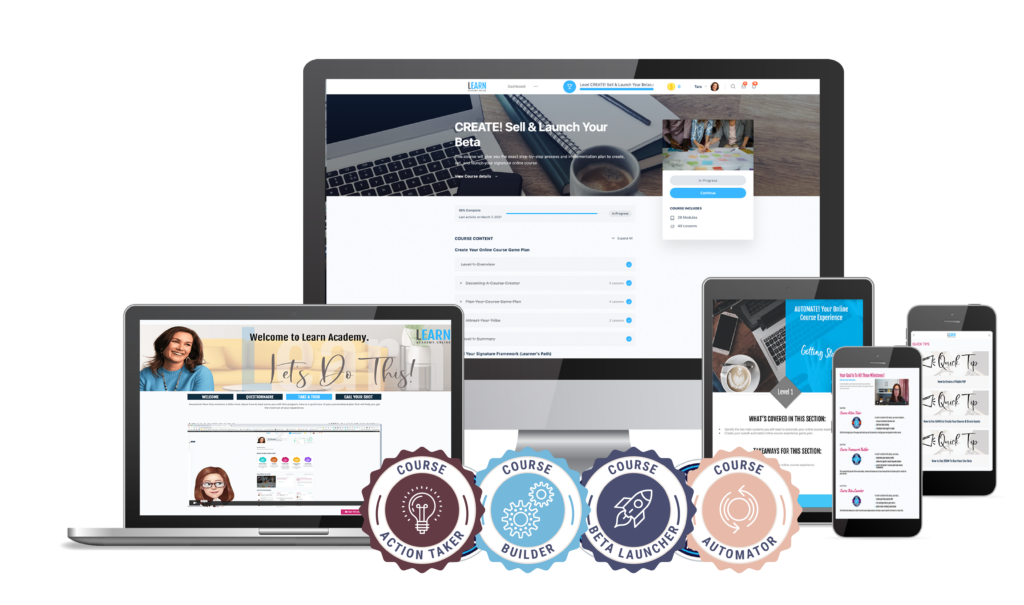Guess what? You’re doing it wrong.
I know that sounds harsh, but if you’re a business owner, coach or consultant who thinks “premium access” means being available 24/7 to your customers, you’re sabotaging both your business and your sanity.
Here’s the uncomfortable truth: Your customers don’t actually want access to you. They want access to your ability to give them the fastest path to their transformation.
And there’s a world of difference between the two.
But here’s what most people miss entirely: before you can even think about access, you need something far more fundamental.
You need a proven path that consistently takes people from where they are to where they want to be.
Without that foundation, all the access in the world becomes a dangerous distraction that actually prevents your customers from getting results.
The Fatal Flaw in How We Think About Client Service – ’24/7 Access’
Most online business owners fall into one of two camps:
Camp 1: The Always-On Martyrs These are the business owners, coaches and consultants who promise “unlimited access” and then find themselves drowning in DMs, emails, and support requests at all hours. They think being constantly available equals premium service.
Camp 2: The Access Avoiders These business owners, coaches and consultants got burned by Camp 1’s approach, so they swing completely the other direction. They create solutions with zero live interaction, no support, and wonder why their completion rates are terrible and customers complain about feeling abandoned.
Both approaches miss the mark entirely.
Your customers aren’t paying for your time. They’re paying for transformation. And transformation happens when people follow a proven path from A to B – not when they can text you at midnight with every random thought and question that pops into their head.
The Framework-First Approach Must Come First: Create Your Signature Framework
Before we dive into access strategies, we need to address the elephant in the room. Most business owners, coaches and consultants are putting the cart before the horse.
They’re obsessing over how to provide access to themselves before they’ve created a reliable system that produces consistent results for their customers.
Here’s what I mean: every successful business owner, coach or consultant has a unique way of taking people from Point A (their current situation) to Point B (their desired outcome). This isn’t just a collection of tips and strategies – it’s a systematic framework that works reliably, regardless of who’s implementing it.
Your signature framework is your business’s DNA. It’s the consistent process you use to create transformation, the methodology that sets you apart from every other expert in your space.
But here’s the problem: most never actually document and systematize their framework. Instead, they wing it. They create content on the fly, answer questions reactively, and wonder why their results are inconsistent.
When you don’t have a solid foundational framework, you become the bottleneck in your customers’ success. Every question feels urgent because customers don’t have a clear path to follow. Every roadblock becomes a crisis because there’s no systematic way to overcome obstacles.
This is why so many feel like they need to be available 24/7. Their customers are constantly getting lost because there’s no clear map to follow.
Why Being Too Available Actually Hurts Your Customers
Here’s a controversial truth that might make you uncomfortable: being too available to your customers is actually a disservice to them.
When you make yourself constantly available, you’re training your customers to become dependent on you instead of developing their own problem-solving abilities. You’re teaching them to reach for their phone every time they hit a minor obstacle instead of working through the systematic process you’ve created.
Think about it this way: if someone is learning to drive, what’s more helpful – having an instructor in the passenger seat for every single trip, or teaching them the rules of the road so they can navigate independently?
The constantly available instructor creates dependent drivers who panic the moment they’re alone. The systematic instructor creates confident drivers who can handle unexpected situations because they understand the underlying principles.
Your job isn’t to be available. Your job is to create a system that makes your availability unnecessary.
When customers constantly reach out for help with basic issues, it’s usually because:
- Your foundational training isn’t comprehensive enough
- Your framework isn’t clear or systematic enough
- You haven’t anticipated and addressed the most common obstacles
- You’re inadvertently rewarding dependency instead of self-sufficiency
Every time you drop everything to answer a question that should have been covered in your core training, you’re pulling that customer off the proven path and into a custom detour that may or may not lead to success.
The Framework-First Approach: Build Your Foundational Training Curriculum
Your foundational training curriculum should be built around your signature framework – the step-by-step process that reliably takes people from their starting point to their goal.
This isn’t just a series of videos or modules. It’s a carefully designed learning experience that:
- Follows a Logical Progression Each step builds on the previous one. Students can’t skip ahead because they haven’t developed the foundational skills needed for advanced concepts.
- Anticipates Common Obstacles You’ve identified the top 20 places where people typically get stuck and built solutions directly into the curriculum.
- Includes Built-in Accountability Students have clear milestones and checkpoints that help them stay on track without needing to ask “Am I doing this right?”
- Addresses Mindset and Tactical Issues You’re not just teaching what to do – you’re addressing the mental blocks and limiting beliefs that prevent implementation.
- Creates Progressive Competence By the end of each module, students have developed specific skills and confidence that carry forward into the next phase.
Here’s what most business owners, coaches and consultants miss: your foundational curriculum needs to be so comprehensive and well-designed that 80% of your customers can succeed by following it alone.
If you’re getting constant questions about basic concepts covered in your core training, the problem isn’t that customers need more access to you. The problem is that your foundational training isn’t doing its job.
The Framework-First Approach: The Hidden Cost of Skipping the Foundational Work
When business owners, coaches and consultants skip the hard work of building a solid foundation, they create what I call “The Support Spiral”:
- Customers get confused because the path isn’t clear
- They reach out with basic questions
- You provide custom answers that work for that specific person
- Other customers see different advice and get more confused
- You get more questions requiring more custom responses
- Your workload increases while customer results decrease
- You burn out and customers feel unsupported
Meanwhile, business owners, coaches and consultants with solid foundational frameworks experience “The Success Spiral”:
- Customers follow a clear, proven path
- Most obstacles are anticipated and addressed in the training
- Students develop confidence and self-sufficiency
- Questions become more advanced and strategic
- You can focus on high-level guidance instead of basic troubleshooting
- Customer results improve while your workload decreases
The difference isn’t the quality of the instructor. It’s the quality of the system.
Framework-First Approach: What Your Customers Really Want (According to the Data)
One survey, asked 1,247 customers across 15 different industries about what “access” meant to them. The results might surprise you:
- Only 12% wanted direct access to the coach/consultant
- 67% wanted fast access to answers when they got stuck
- 74% preferred self-serve resources over waiting for personal responses
- 89% valued consistent, predictable access over immediate access
- 91% would choose a program with great systems over one promising 24/7 availability
But here’s the most telling statistic: 94% of students said they preferred programs with clear step-by-step frameworks over programs that promised unlimited personal support.
The message is clear: customers want reliable access to solutions within a proven system, not unpredictable access to people who might lead them astray from the main path.
The False Beliefs That Keep You Trapped
Let’s address the limiting beliefs that keep course creators stuck in the access trap:
False Belief #1: Premium means personal
Reality: Premium means effective. Your customers pay premium prices for premium results, not premium access to your calendar.
False Belief #2: If I’m not always available, customers will feel abandoned
Reality: Inconsistent availability creates more anxiety than predictable boundaries. Students prefer knowing they’ll get help within 48 hours over wondering if you’ll respond to their 9 PM message.
False Belief #3: Automation and systems feel impersonal
Reality: Good systems feel more personal because they’re designed around your customers’ actual needs, not your availability.
False Belief #4: I need to be accessible to justify my prices
Reality: You justify your prices with results, not response times. A $5,000 program with a 90% success rate beats a $500 program with unlimited access and a 20% success rate every time.
False Belief #5: My framework isn’t special enough to build a program around
Reality: Your framework doesn’t need to be revolutionary. It needs to be reliable. The magic isn’t in having a completely unique approach – it’s in having a systematically documented approach that consistently produces results.
Step 1: Document Your Signature Framework (Before Building Any Systems)
Before you can create scalable delivery, you need to get crystal clear on your signature process for creating transformation. Here’s how:
The Framework-First Approach Extraction Process
Week 1: Success Story Analysis Look at your last 10 successful clients or customers.
- What specific steps did each one go through?
- What was the sequence of events that led to their breakthrough?
Document every phase, milestone, and turning point.
Week 2: Obstacle Identification
For those same 10 success stories, identify every major obstacle they encountered and how they overcame it.
These obstacles become predictable checkpoints in your framework where you’ll need to provide extra support and guidance.
Week 3: Framework Documentation
Create a step-by-step process map that captures the common elements from your success stories. This should be specific enough that someone else could follow it and get similar results.
Week 4: Validation and Refinement
Test your documented framework with a small group of beta students.
Track where they get stuck, what questions they ask, and what results they achieve.
Refine the framework based on this feedback.
The Framework-First Approach Formula
Your signature framework should follow this structure:
Phase 1: Foundation Setting – What mindset, skills, or preparation is required before they can start the main work?
Phase 2: Core Implementation – What are the 3-7 main steps they need to execute in order?
Phase 3: Integration and Optimization – How do they refine and improve their results over time?
Phase 4: Scaling and Sustainability – How do they maintain and expand their success?
Each phase should have clear entry criteria (what must be true before they can start this phase) and completion criteria (what must be achieved before moving to the next phase).
The Scalable Delivery Framework: 5 Systems That Work While You Sleep
Once you have your framework-first approach foundation in place, you can build scalable delivery systems that support the framework instead of undermining it:
System 1: The Framework Progress Portal
Most support requests stem from people feeling uncertain about their progress within your system. Create clear checkpoints and progress indicators for each phase of your framework.
Implementation: Build a simple LMS tracking system where students can:
- See which phase of your framework they’re currently in
- Understand what they need to complete before moving forward
- Access phase-specific resources and troubleshooting guides
- Celebrate milestones as they progress through your system
Advanced Strategy: Include “Framework Audit” questions at each checkpoint that help students self-diagnose whether they’re ready to move forward or need to spend more time in their current phase.
System 2: The Framework-Aligned FAQs
Create a searchable database of responses organized around your signature framework. Unlike generic FAQs, this archive is structured to guide people back to the main path when they get distracted.
Implementation: For each phase of your framework, create a section that addresses:
- Common questions for that specific phase
- How to get back on track if they’ve veered off course
- What success looks like at that stage
- When it’s appropriate to move to the next phase
Pro Tip: Every answer should include a “Return to Path” element that guides them back to the specific step in your framework they should focus on next.
System 3: The Peer Connection + Success Network
Your successful students are your best support team. Create structured ways for them to help newer students.
Implementation: Create a simple mentorship matching system, peer review processes, or gamify helping others with points and recognition.
System 4: The Framework-Focused Power Hour
Instead of scattered one-off responses that can lead people astray, batch all questions into a weekly group session specifically designed to get people back on track with your framework.
Implementation: Host a weekly “Framework Focus” call where you:
- Answer submitted questions through the lens of your signature framework
- Help people identify which phase they should be focusing on
- Address common obstacles that arise at each stage
- Celebrate students who are successfully following the process
Key Difference: Unlike generic Q&A calls, every answer reinforces the main path rather than creating custom detours.
System 5: The Emergency Escalation
For the rare truly urgent situation, create a clear escalation path. This might be a slack channel, voxer, separate email address, a premium support tier, or specific criteria for when someone can request immediate help.
Implementation: Define what constitutes an “emergency” in your program and create a simple process for these situations. Make it clear this is for genuine emergencies only.
The Compound Effect of Framework-First Thinking
When you build your business around a solid framework first and then create access systems to support that framework, something magical happens:
Your customers get better results because they’re following a proven path instead of getting distracted by every shiny object or obstacle.
Your workload decreases because most questions are handled by your framework-aligned systems.
Your expertise compounds because you’re deepening your mastery of one systematic approach instead of constantly creating custom solutions.
Your business becomes more valuable because you have intellectual property (your framework) that can be licensed, franchised, or sold.
Your confidence increases because you know exactly what works and why.
Case Study: The Framework Transformation
Let me share a real example of how this framework-first approach:
Before: Marcus ran a $3,000 marketing program but felt like he was running a custom-project business instead of a scalable business. Customers would come to him with wildly different situations and expect custom strategies for their specific industries, business models, and goals. He was working 70+ hours a week creating personalized action plans and still had customers complaining that the program wasn’t specific enough for their needs.
The Problem: Marcus was trying to be everything to everyone. He had great marketing knowledge but no systematic way of applying it. Every customer interaction was essentially a custom consulting session.
The Framework Solution: After documenting Marcus’s “Universal Marketing Momentum Method” – a 3-phase system that worked regardless of industry or business model:
- Phase 1: Market Clarity – Identify your ideal customer
- Phase 2: Message Development – Create compelling offers and positioning
- Phase 3: Channel Mastery – Systematically test and optimize marketing channels
After: Once Marcus rebuilt his program around this framework, everything changed. Students stopped asking for industry-specific advice because the framework was universal. Support requests dropped by 78% because the step-by-step process anticipated most obstacles. Most importantly, student success rates increased from 34% to 81% because people were following a proven system instead of trying to implement random tactics.
The Revenue Impact: With his new framework-based approach, Marcus was able to raise his prices to $5,000 while actually providing less personal access. His profit margins increased by 240% and his working hours decreased to 35 per week.
The Real Cost of Avoiding a Framework-First Approach
I know what you’re thinking: “This framework-first approach sounds like a lot of work. Can’t I just focus on providing great access and support?”
Here’s the truth: you’re already doing the work. Every time you answer a custom question, create a personalized solution, or help someone troubleshoot their specific situation, you’re doing framework development work – you’re just not capturing the value.
When you don’t document your framework:
- You solve the same problems over and over instead of solving them once systematically
- Your customers get inconsistent advice depending on your mood, energy level, or recent experiences
- You can’t scale beyond your personal time and energy
- Your business knowledge leaves with you if you get sick, take a vacation, or want to sell
- New team members can’t replicate your success because they don’t understand your methodology
When you do the upfront work of framework-first approach:
- You solve problems once and create systems that handle them forever
- Your customers get consistent, reliable guidance that builds on itself
- You can scale without being personally involved in every decision
- Your business has intellectual property that adds real value
- You can train others to deliver your methodology at scale
Common Objections
“But my customers expect immediate responses” They expect reliable responses. Set clear expectations about response times and then exceed them consistently.
“My niche is too complex for automated systems” Every niche has common patterns. Start by systematizing the top 10 questions you get asked. That alone will handle 60-70% of your support load.
“I don’t have time to build these systems” You don’t have time NOT to build them. Every hour you invest in systems saves you 10 hours in manual support down the line.
“My competitors offer 24/7 access” Your competitors are probably burning out or delivering poor-quality rushed responses. Offer better access, not faster access.
Beyond ‘Access’: The Framework Advantage
When you shift from providing access to yourself to providing access to a proven framework, you’re not just solving a business problem – you’re creating a competitive advantage.
Your customers prefer frameworks because they provide certainty and clear progress markers in an uncertain world.
You prefer frameworks because they allow you to scale your expertise without scaling your time.
The market rewards frameworks because they represent systematized expertise that can be evaluated, compared, and trusted.
Your framework becomes your signature differentiator – the thing that sets you apart from every other expert offering similar results. It’s not just what you teach; it’s how you consistently create transformation.
And once you have that foundation in place, access becomes simple. You’re not providing access to your time or availability. You’re providing access to a proven system that works with or without you.
The Framework-First Approach Advantage
When you combine a solid framework foundation with scalable delivery systems, everybody wins:
- Your customers get predictable transformation through a proven process
- You reclaim your time while actually improving customer results
- Your business becomes more scalable, valuable, and sustainable
- You can focus on what you do best: refining and improving your systematic approach to creating change
Remember: Your customers didn’t buy your solution to become your friend or to have unlimited access to your calendar. They bought it to solve a problem and achieve a goal through a reliable process.
Give them a framework that consistently delivers results, supported by access systems that keep them on track, and they’ll thank you for the clarity and structure.
The question isn’t whether you can afford to build these systems. The question is whether you can afford to keep winging it with custom solutions that don’t scale.
Your future self – and your customers – will thank you for making the shift from access-focused to framework-focused business building.
The most successful businesses aren’t the most available ones. They’re the ones with the most reliable systems for creating transformation.
Which one do you want to be?
Ready to build your signature framework and scalable access systems? Start with the booking a free discovery call. You’ll be amazed at how much more effective your business becomes when you stop playing support ticket whack-a-mole and start systematically guiding people through proven transformations.







